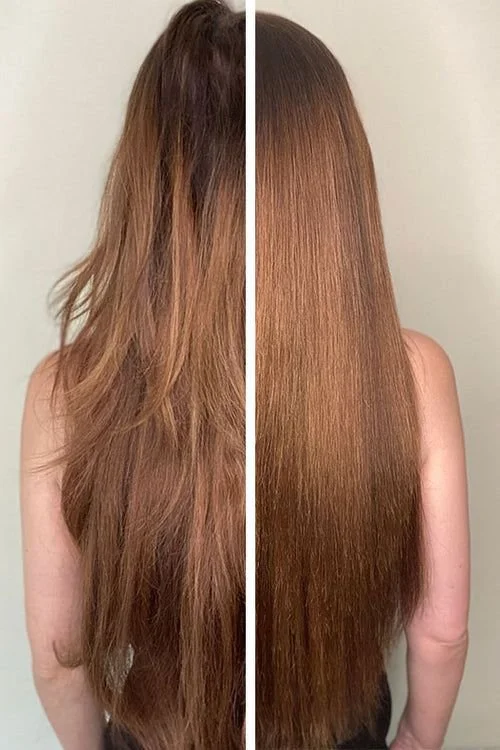Keratin: Can I Color and Do Keratin the Same Week? What Our Stylists Recommend
Keratin is one of the most popular treatments in modern hair care, loved for its ability to smooth frizz, add shine, and make hair more manageable. But one of the most common questions clients ask is: “Can I color and do keratin the same week?” This is an important concern because both coloring and keratin involve chemical processes, and the timing between them can affect the results, longevity, and health of your hair.
In this article, we’ll explore what happens when you mix color and keratin treatments too closely, the best order to do them in, and what professional stylists truly recommend.
Understanding Keratin Treatments
Keratin treatments are designed to smooth the cuticle of the hair and lock in proteins that reduce frizz and add shine. Unlike traditional chemical relaxers, keratin does not permanently alter the structure of your hair—it simply coats the strands with proteins and seals them with heat.
This process typically lasts between 3 to 5 months, depending on the type of keratin used, your hair texture, and your aftercare routine. Because the treatment seals the hair cuticle, it can sometimes impact how color deposits or fades. That’s why the timing of your coloring session matters.
How Hair Color Works
Hair coloring involves opening up the cuticle layer so pigment can penetrate into the cortex of the hair strand. Whether you’re using permanent, demi-permanent, or semi-permanent dye, the coloring process alters the hair’s chemical structure to some extent.
Since keratin treatments focus on sealing the cuticle, doing color before or after keratin can produce very different outcomes. For example:
If you color first, then do keratin: The keratin may “lock in” your new shade, making it last longer.
If you do keratin first, then color: The color may not penetrate properly because the cuticle has already been sealed, leading to uneven or faded results.
Can I Color and Do Keratin the Same Week?
The short answer is: it depends on the order and the type of service you want. Most stylists recommend not doing both in the same week, especially if you want your results to last and your hair to stay healthy.
Here’s why:
Color right after keratin doesn’t work well
Since the cuticle is sealed, the pigment can’t fully absorb into the hair shaft. Your color may appear dull or wash out quickly.Keratin right after color can actually be beneficial
If done properly, the keratin can help lock in the fresh pigment and reduce fading. However, if the color is very fresh (same day), the chemicals may overlap and cause irritation or unpredictable results.Doing both within days stresses the hair
Hair is sensitive to chemical treatments. Doing both keratin and color in the same week can lead to dryness, breakage, or overprocessing, especially if bleaching is involved.
What Stylists Recommend: The Right Order
Professional stylists generally advise the following:
1. If you want to color first, then do keratin
Get your hair colored at least 3 to 5 days before your keratin treatment.
This gives your hair time to stabilize and ensures the pigment is set.
The keratin will then seal in the color, making it last longer with added shine.
2. If you want to do keratin first, then color
Wait at least 2 to 3 weeks after your keratin treatment before applying hair color.
This prevents the keratin from being stripped away and allows the cuticle to open slightly for better color absorption.
3. For blondes or lightened hair
Always color before keratin, not after.
Bleaching after keratin can strip the treatment completely, leaving hair brittle.
Why Timing Matters for Hair Health
Your hair can only handle so much chemical processing at once. Even though keratin is not as harsh as relaxers or perms, it still uses heat and chemical bonds to work. Pairing that with hair dye (especially ammonia-based formulas or bleach) within the same week risks weakening the hair shaft.
By spacing out the treatments, you allow your strands to “recover” and better absorb the benefits of both services. In the long run, this means:
Stronger hair with less breakage
Longer-lasting color with reduced fading
Keratin results that last for months rather than weeks
Common Mistakes to Avoid
Many clients make mistakes when combining keratin and color. Here are the most common ones and how to avoid them:
Doing both on the same day → This usually leads to poor color results.
Bleaching after keratin → Strips the treatment and damages hair.
Using the wrong shampoo → Sulfate shampoos can ruin both color and keratin results.
Not consulting a stylist → Every head of hair is different; a consultation ensures personalized advice.
Aftercare Tips for Color and Keratin
No matter which order you choose, aftercare is essential to maintaining healthy hair and maximizing the life of both treatments. Stylists recommend:
Use sulfate-free shampoo and conditioner designed for keratin-treated hair.
Wash less frequently (2–3 times a week) to avoid stripping treatments.
Protect from heat by using thermal protectant sprays when styling.
Avoid chlorine and saltwater which can fade color and weaken keratin.
Deep condition weekly to keep strands hydrated and strong.
What If You’re in a Rush?
Sometimes clients have a special event or trip coming up and want both treatments quickly. If you must do them close together, stylists recommend:
Color first, then keratin a few days later (not the same day).
Opt for a gentler coloring option, such as ammonia-free or demi-permanent dye.
Be prepared that results may not last as long as when spacing them out properly.
Final Word from Stylists
So, can you color and do keratin the same week? Technically yes—but it’s not ideal. The professional recommendation is:
Color first, wait a few days, then apply keratin.
If keratin comes first, wait 2–3 weeks before coloring.
This way, you preserve both your color vibrancy and the smoothing benefits of keratin. At the end of the day, healthy, shiny hair is worth the patience.
Conclusion
Keratin treatments and hair coloring are both excellent ways to enhance your look, but timing is everything. By understanding how each process affects the hair cuticle and by following your stylist’s recommendations, you can enjoy vibrant color and silky-smooth strands without compromise.
Remember: your hair is an investment. Give it the care and timing it deserves, and it will reward you with beauty and confidence for months to come.




